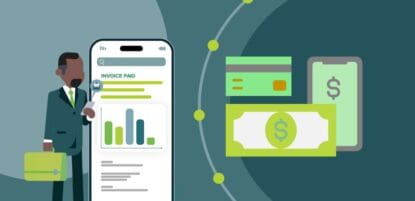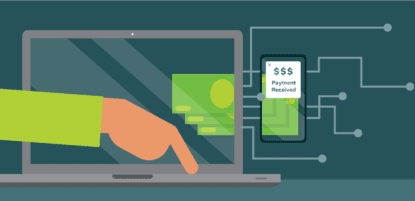Too many businesses still find themselves stuck in the same monthly routine—chasing down invoices, manually sending payments, and double-checking spreadsheets to keep things moving. It’s repetitive, time-consuming, and completely avoidable.
Recurring payments have become a cornerstone of modern accounts payable (AP) operations, offering a smarter, more streamlined alternative. They allow businesses to automate regular transactions and eliminate tedious manual processes.
Whether it’s monthly software subscriptions, quarterly leases, or ongoing vendor services, recurring payments help maintain cash flow consistency, improve vendor relationships, and reduce the risk of human error. As companies scale and vendor networks grow more complex, adopting a streamlined and automated approach to recurring payments is key to long-term success.
Key takeaways
- Recurring payments streamline AP processes by automating scheduled transactions, reducing manual effort, and ensuring consistent cash flow across vendor relationships.
- Automation minimizes risk and boosts accuracy, eliminating common errors and fraud vulnerabilities through audit trails, approval workflows, and real-time visibility.
- A reliable AP automation solution enhances scalability, helping businesses manage fixed and variable recurring payments efficiently while maintaining strong vendor trust and operational transparency.
When to use recurring payments vs. one-time payments
Recurring payments are best suited for expenses that occur on a regular schedule and remain relatively consistent in amount, such as software subscriptions, office rent, utilities, or ongoing service retainers. These transactions benefit from automation because they’re predictable and don’t require individual oversight each time.
One-time payments are better suited for infrequent, variable, or project-based expenses, such as equipment purchases, freelance work, or one-off vendor invoices. These often require more review or approval and may involve more complex terms or pricing.
The key is to automate where predictability exists. If a payment recurs at set intervals with known terms, it’s a strong candidate for automation. Keeping it manual allows for greater control if it’s irregular, high-value, or requires case-by-case evaluation.
What are recurring payments for businesses?
Recurring payments are automated financial transactions that occur at regular intervals—weekly, monthly, quarterly, or annually, based on previously agreed-upon terms. B2B payments typically involve transactions for subscriptions, retainers, service agreements, equipment leases, and other ongoing commitments.
Rather than requiring someone from the finance team to initiate every transaction manually, recurring payments are set up to execute automatically. This automation saves time, supports predictable budgeting, and ensures continuity in operations, which is especially valuable for businesses with large vendor networks or high payment volumes.
How recurring payments work
Recurring payments function through clearly defined terms between the business and the vendor. These terms typically include:
- Frequency: How often the payment is made (e.g., monthly, quarterly).
- Amount: A fixed payment (e.g., software subscription) or a variable amount based on usage (e.g., utilities or consulting hours).
- Payment method: Typically ACH, credit card, wire transfer, or other forms of electronic payment.
- Authorization: A formal vendor agreement or billing contract that permits automatic withdrawals or payments.
Once these terms are in place, an automated payment system schedules and processes the payments accordingly. Many businesses rely on online bill pay systems as a simple entry point to automate recurring vendor transactions before upgrading to end-to-end AP automation platforms.
These advanced systems also provide features such as real-time alerts, payment reminders, and the ability to set approval workflows that align with internal controls and compliance policies.
How to set up recurring payments in your AP workflow
Implementing recurring payments successfully starts with the proper foundation. By following a structured approach, businesses can ensure accuracy, efficiency, and scalability from day one.
1. Choose the right payment platform
Start by selecting a payment platform that supports automated recurring transactions, flexible scheduling, and integration with your existing systems. Look for features like customizable approval workflows, audit trails, and secure vendor management.
2. Integrate with your AP system
Seamless integration between your payment platform and AP system is critical for ensuring seamless data flow and accurate financial reporting syncing. This ensures all payment activities are tracked in real-time and reflected in your accounting records. Integration also reduces manual entry and errors and saves time.
3. Set up payment schedules
Define clear payment terms with vendors, including frequency, amount, and due dates. Then, enter those parameters into your system. Automating these schedules ensures that payments are made on time without human intervention. Consistent scheduling also supports better cash flow forecasting and vendor satisfaction.
4. Automate invoice generation
Enable automation to generate invoices based on predetermined criteria for recurring transactions that require invoices. This ensures that invoices are created, sent, and processed promptly, keeping payment workflows running efficiently. Automation also standardizes invoice formatting and data, simplifying validation and approvals.
5. Monitor and manage payments
Even with automation, ongoing oversight is essential. Use dashboards and reporting tools to track payment status, flag exceptions, and ensure everything runs smoothly. This visibility helps catch issues early, such as failed payments or outdated vendor details, before they cause disruptions.
The business benefits of recurring payments
Recurring payments deliver real, measurable value across your finance operations. From saving time to strengthening vendor relationships, automation offers several key advantages, including the following:
- Improved efficiency
- Reduced manual errors
- Better vendor relationships
Improved efficiency
Recurring payments drastically reduce the time and resources spent on manual payment processing. Finance teams no longer need to generate invoices, collect approvals, or manually transfer funds for every transaction. Instead, automated invoice payment systems handle scheduling and execution, allowing staff to focus on other work, such as forecasting, vendor negotiations, and financial planning.
Reduced manual errors
Manual data entry in traditional AP processes often leads to costly mistakes, including incorrect payment amounts, duplicate payments, and overdue payments. However, B2B payment automation eliminates these risks for recurring payments by standardizing payment details and automating validation steps. With the right system, approvals are built into the workflow, minimizing room for error.
Better vendor relationships
Reliable and timely payments help build trust with vendors. When suppliers receive consistent on-time payments, they’re more likely to prioritize your business, offer favorable contract terms, and extend credit. Recurring payments demonstrate professionalism and predictability—essential traits in long-term B2B partnerships.
Best practices for managing recurring payments
Managing recurring payments effectively takes the right combination of strategy, technology, and oversight. By following these best practices, you can ensure consistency and maximize the long-term value of your AP processes.
Automate recurring billing
Automating recurring billing ensures that payments are initiated on time without requiring manual input. This reduces delays, avoids late fees, and frees your finance team from repetitive tasks. It also creates a consistent, predictable process that vendors can rely on.
Ensure payment security
Security is critical when managing recurring payments, especially at scale. To safeguard financial data, use an AP platform with encryption, role-based access, and fraud detection tools. A secure setup protects your business from cyber threats and helps maintain regulatory compliance.
Track payment schedules
A clear view of payment timing is essential for managing cash flow and avoiding missed deadlines. Use dashboards, reminders, and reporting tools to track all scheduled and completed transactions. Regular monitoring also helps identify anomalies before they impact operations.
Handle payment failures
Even automated payments can fail due to insufficient funds, incorrect account details, or expired authorizations. Set up alerts and workflows that flag failed transactions, so your team can act quickly. Addressing payment failures promptly helps maintain trust with vendors and avoids service disruptions.
Integrate with ERP systems
Integrating your accounting or ERP system with AP automation tools creates a seamless flow of financial data. This eliminates manual data entry, reduces errors, and improves accuracy in reporting. It also simplifies reconciliation at month-end and supports real-time financial visibility.
What to look for in a recurring payments automation solution
Look for a solution that supports flexible scheduling, approval workflows, and integration with your existing ERP or accounting software. It should offer customizable controls, detailed reporting, and intuitive dashboards for complete visibility into recurring payment activity.
Security features like role-based access and audit trails are essential for compliance and fraud prevention. Finally, a user-friendly interface ensures fast adoption by finance teams and smoother vendor onboarding.
How MineralTree’s AP automation solution supports recurring payments
MineralTree streamlines the entire recurring payments process through our advanced AP automation platform. With MineralTree, you can set up recurring payment schedules, define and enforce customized approval processes, and manage vendor details all in one place. Built-in dashboards and reporting tools also make it easy to monitor upcoming, pending, and completed payments so your finance team is never in the dark.
Plus, MineralTree syncs seamlessly with leading ERP integration systems, enabling end-to-end transparency and eliminating silos across accounting, procurement, and finance teams.
Whether dealing with fixed-rate subscriptions or variable usage-based billing, MineralTree’s tools are designed to adapt to your business needs. Get in touch today to transform your back office with AP automation.

Recurring payments FAQs
What are the disadvantages of recurring payments?
If you’re not using robust automation tools, recurring payments may lead to oversights, such as making payments on outdated vendor contracts or rates. However, using an end-to-end AP automation solution that is fully integrated with your ERP can help you avoid these issues.
What’s the difference between fixed recurring and variable recurring payments?
Fixed recurring payments, such as software subscriptions, remain consistent in amount and timing. In contrast, variable recurring payments, like utilities or hourly consulting services, fluctuate based on usage. While both types can be automated, variable payments require extra data validation or approval.
Are recurring payments secure through MineralTree?
Yes. MineralTree protects financial data with bank-level encryption, multi-factor authentication, and secure vendor onboarding processes. Role-based access controls ensure that only authorized users can view or modify payment settings.
How does AP automation help improve visibility into recurring payments?
AP automation offers real-time dashboards, custom reporting, and detailed payment history logs. These features provide a comprehensive view of upcoming, pending, and completed payments and can alert your team to anomalies or exceptions that may require attention. This increased transparency enables better forecasting and more informed financial decision-making.
How can automation help reduce the risk of fraud in recurring payments?
Automation reduces the number of human touchpoints in the payment process, a common source of fraud risk. Features like audit trails for every payment, segregation of duties, and fraud detection flags work together to provide transparency and control. These safeguards significantly reduce the risk of fraud in recurring costs.



